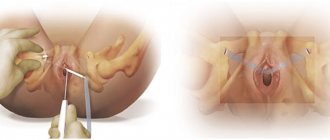Urine is a natural indicator of human health. Changes in its composition, consistency, and smell indicate obvious and hidden pathological processes occurring in the body. Normally, the biofluid has a straw-yellow color, the shade of which varies between light and deep dark. But often it can change the color palette and take on different colors. Green urine is a rare phenomenon, the causes of which are due to eating certain foods, taking medications, or the progression of serious diseases.
Causes of green urine
Human urine acquires its natural yellow color due to the presence of a coloring pigment in its composition - urobilin. The higher its concentration, the more saturated the shade becomes. Influencing factors are the quality of nutrition and the amount of fluid consumed. The appearance of a specific color indicates the presence of a foreign substance in the biofluid. Green urine in an adult can appear for many reasons, so it is extremely difficult to understand the nature of such changes without the help of a doctor.
Food connection
No matter how strange green urine may look, it is not always a reason to panic. First of all, you should pay attention to your diet and the foods you eat. Many of them contain dyes of both natural and synthetic origin. The former do not pose any harm to the body, but the latter can accumulate and be excreted by the kidneys after some time.
Let's figure out why urine turns greenish. Plant foods, namely vegetables, fruits, and herbs, contain a certain amount of pigments. Their concentration in products is variable, since it is determined by the content of vitamins, minerals, and other compounds. By entering into a chemical reaction, they are able to secrete a substance that, when released into the urine, gives it a corresponding shade.
They are most often found in the following products.
| Name | Description |
| Green apples | Unripe fruits contain a high concentration of natural dye |
| Spinach | The leaves are saturated green because they contain an excess amount of pigment. |
| Sorrel | Exhibits coloring properties after heat treatment |
| Asparagus | Gives urine different shades of green |
| Black licorice | Can stain not only urine, but also feces |
| Pistachios | Unripe nuts have an intense color |
| Zhoster | A plant that has a pronounced laxative effect. Infusions, teas, and medications, where it is present, can turn the biofluid green. |
| Beer | The natural dye gives a light green tint not only to the drink, but also to the urine of the person who drinks it |
| Liquorice | When eating this product, yellow-green color of urine is observed. |
It is important to know! The pronounced greenish tint of urine in this situation is temporary, since natural dyes come with food. After a certain period after eliminating the provoking factor, a return to a healthy shade is noted. The abnormal phenomenon completely disappears after the final removal of pigments.
Effect of drugs
Quite often, light green urine is a consequence of drug therapy. Basically, this occurs after taking medications that contain herbal components. But sometimes this phenomenon is observed after using completely synthetic drugs. If, while taking them, a change in the color of urine is noted, it is necessary to report this deviation to the attending physician, who will discontinue the medication or adjust the treatment regimen and replace it with a suitable analogue.
During a course of treatment, changes in urine color can be caused by medications:
- "Indomethacin";
- "Amitriptyline";
- "Propofol";
- "Ripsapin."
An abnormal shade of urine and a viscous consistency appear in most cases as a result of taking antibacterial agents. This is due to a violation of the microflora, which leads to the occurrence of the phenomenon.
Diseases
In addition to the harmless factors of changes in the color of urine, there are serious causes of deviations. These are diseases and pathological conditions, among which the following should be highlighted.
- Leukocyturia. The rich green color of urine indicates an increased content of leukocytes in it. Non-standard staining indicates ongoing infectious and inflammatory processes, such as cystitis or pyelonephritis. During pregnancy, a clear clinical picture is often absent, and the disease can only be detected by examining urine.
- Urinary tract infections. Typically, in such conditions, the bladder, urethra, parenchyma, and interstitial tissue of the kidneys are affected. The urine produced turns green and is excreted in scanty quantities. The process is accompanied by the formation of purulent exudate.
- Liver diseases. When this organ is damaged, a change in the color of urine and feces is noted.
- Gallbladder problems. Excessive amounts of bile provoke the development of pathologies such as jaundice, cholecystitis, as a result of which urine of a greenish tint is noted in an adult.
- False leukocyturia. Abundant purulent discharge due to an infectious lesion of the genitals can cause the urine to become swamp-colored.
- Dysbacteriosis. Violation of the intestinal microflora leads to problems with absorption by its walls. As a result, the process of putrefaction begins, the products of which are excreted in the urine and, accordingly, give it a characteristic greenish tint.
Another reason for changes in the color of urine is infection with helminths. The excreted waste products of worms lead to toxic poisoning of the body and provoke staining of urine and feces.
Prerequisites for adults
Green urine in men and women is a rare occurrence and is considered to be a consequence of the general causes described above. In addition, its appearance can be triggered by factors related to gender.
Women
The causes of a rare phenomenon in a girl or woman are often hormonal imbalances and excessive stress associated with pregnancy. It is during this period that the body is more sensitive to various manifestations, and therefore reacts to changes in diet, including taking medications.
Men
In representatives of the stronger sex, such a pathology can be triggered by the development of prostatitis or sexually transmitted infections. As a rule, it appears against the background of a severe course of the disease. In addition, the green tint of urine may not be associated with a malfunction of the body.
Abnormal color of urine in children
Urine in a newborn is colorless and transparent, in infants and babies up to one year old it is light yellow. The appearance of green urine at this age is almost always due to the presence of health problems, and therefore should alert parents. Thus, greenish or blue urine indicates the presence of a genetic pathology - hypercalcemia. A light-brown tint in a child indicates the development of jaundice.
In order to identify it promptly and correctly, you should pay attention to the characteristic symptoms:
- sudden weight loss;
- the appearance of unbearable itching;
- increase in body temperature to subfebrile values;
- yellowish coloration of the skin and mucous membranes;
- discoloration of stool;
- pain in the hypochondrium area.
Tests reveal elevated levels of bile acid, bilirubin, and liver enzymes.
In older children, a change in the color of urine can occur as a result of the predominance of foods of plant origin (fruits, vegetables, herbs) in the diet, taking certain medications, or the development of diseases. The list of the latter is quite wide: from disorders of the urinary system and pathologies of the gastrointestinal tract to disorders of the functioning of the parathyroid glands. Characteristic signs of the disease give the doctor direction for further examination and choice of treatment regimen.
Causes of green urine in children and adults
- Why
- Diseases
- Medicines
- Products
- Other reasons
- During pregnancy
- Among women
- In men
- In children
- When to see a doctor
The color of urine characterizes the performance of many organs and systems. The urine of a healthy person is light yellow (straw) in color. Biological fluid analysis is recommended for all patients who have health problems.
Have you been fighting CYSTITIS for many years without success?
Head of the Institute: “You will be amazed at how easy it is to cure cystitis by taking it every day...
Read more "
Why
Blue-green or green urine is an abnormal phenomenon that indicates changes in the body. In most cases, a change in the color of urine is the result of a disorder of the urinary system. But there are also harmless reasons.
Diseases
The color can be changed by an infection that affects the urinary tract, thyroid disease (hyperparathyroidism), liver pathology, etc.
A preliminary diagnosis can be made by accompanying symptoms.
If the urine turns bright green, it contains flakes visible to the naked eye, and a urine test shows a high content of leukocytes, then this indicates an inflammatory process in the bladder mucosa. With cystitis, the patient feels pain and burning during urination.
Other urinary tract infections that can cause the fluid produced by the kidneys to appear greenish include:
- nephritis;
- pyelonephritis;
- urethritis, etc.
The light green color of the biological fluid is characteristic of gonorrhea or other urogenital infection. This symptom of the disease occurs as a result of mucus and pus entering the urine.
Additionally, the patient begins to complain of frequent urination, which is accompanied by a burning sensation and pain in the lower abdomen. Green color of urine, which is combined with bloating and vomiting, may indicate gallbladder disease or peritonitis. And if the skin acquires a yellowish tint, this indicates liver disease.
Medicines
Some drugs can give urine a green color if they contain a coloring pigment. These medications include:
- Tagamet;
- Phenegran;
- Rispasin;
- Methindol;
- vitamins.
Liver collection, which contains medicinal herbs, has a choleretic effect.
During its use, the color of the biological fluid may become yellow-green. Such changes do not require medical intervention. The color of urine returns to normal when the drug is completely eliminated from the body.
Products
Natural and synthetic dyes found in foods can give urine a green color.
It could be:
- herbal beer;
- licorice;
- liquorice;
- asparagus;
- rhubarb;
- artificial drinks (juices, soda, etc.).
The color of urine can only change with excessive consumption of green foods of natural origin. Low-quality synthetic pigment for coloring culinary dishes can also affect the color of urine and also cause health problems. It can cause poisoning of the body.
Poor nutrition, which leads to a long digestion process, can affect the color palette of the patient's biological fluid.
Congestion in the rectum provokes the process of decay. Decomposition products are excreted from the body in urine. They give urine a green color with a blue tint.
Other reasons
In some patients who have been given an anesthetic such as Profopol during surgery, the urine may turn green or pink. This phenomenon is temporary, and it will disappear after the remnants of the drug leave the body.
Monitoring of body secretions is necessary for patients undergoing liver or gallbladder surgery. Green urine can be caused by an increase in bilirubin levels.
Peculiarities
Blue or light green urine may be caused by familial hypercalcemia. This is a rare disease that is transmitted genetically.
During pregnancy
While carrying a child, the female body undergoes various hormonal and physical changes. Increased load can provoke disruption of the functionality of internal organs or cause exacerbation of chronic diseases. For this reason, a woman is recommended to regularly have her urine tested.
If the biological fluid becomes green with a brown tint, this may be a symptom of gallbladder or liver pathology.
A pregnant woman's urine may turn light green if the woman experiences leakage of amniotic fluid. Normally, amniotic fluid is colorless. But if pregnancy is complicated by intrauterine hypoxia of the fetus, its color becomes green (the sphincter of the baby’s rectum relaxes, and meconium enters the amniotic fluid, which changes its color). At the time of urination, urine mixes with the amniotic fluid, which leads to a change in the color of the urine. This pathology is considered dangerous.
Among women
The presence of green urine along with copious purulent discharge may be a sign of the following genital infections:
- vulvitis;
- vaginitis;
- vulvovaginitis;
- colpitis;
- endometritis.
In men
Prostatitis can provoke a change in urine color. Inflammation of the prostate gland is additionally accompanied by pain in the groin and difficulty urinating.
To treat cystitis, our readers successfully use Galina Savina’s method
This cheap odorous remedy will get rid of cystitis forever! Sold in every pharmacy, called...
Harmless reasons that give biological fluid a blue color include the use of Viagra.
In children
Light green urine in a child may indicate dysbiosis. This pathology is often a consequence of long-term use of antibacterial agents or occurs as a result of poor nutrition.
Discoloration of stool, sudden weight loss, pain in the ribs, yellow discoloration of the epidermis and mucous membranes can suggest that the child has obstructive jaundice.
What to do
If the urine has changed color, but there are no other pathological symptoms, it is recommended to analyze your diet and study adverse reactions from the medications you are taking. If any disputes arise, you should contact the hospital.
When to see a doctor
Medical attention is necessary when green urine is accompanied by other symptoms:
- increased body temperature;
- chills;
- nausea;
- abdominal pain;
- pathological discharge from the urethral canal or vagina;
- yellowing of the skin, etc.
Establishing diagnosis
To determine the cause of the pathological change in the color of the biological fluid, the doctor conducts a general survey of the patient, examines the skin and prescribes a urine test. If there are accompanying symptoms, additional diagnostics may be required. It will depend on the nature of the signs of illness.
After the results of laboratory tests are received and deciphered, the doctor prescribes appropriate treatment.
Danger signs
When starting diagnostic measures, the doctor first examines the urine. And if it changes its color, then against the background of a deterioration in the patient’s well-being, this indicates the development of some disease. Each of them is characterized by a specific symptom complex.
In liver diseases, recognizable signs are: belching, nausea, vomiting, bloating, diarrhea, bitterness in the mouth. Greenish urine accompanies changes in the color of stool. Gallbladder diseases are accompanied by excessive secretion of bile. The patient feels weakness, sweating, thirst, pain in the abdominal cavity, and bouts of vomiting. In severe cases, an increase in body temperature and a febrile state is observed.
Infectious and inflammatory processes of the genitourinary organs are characterized by a light green color of urine and a frequent urge to empty the bladder. The patient's condition is complicated by burning, stinging, and painful sensations during urination. When the disease worsens, there is increased fatigue, nausea, often ending in episodes of vomiting, and oliguria.
Pathological causes
Often, a change in the color of urine indicates the development of a dangerous illness in the human body. To make an accurate diagnosis, you need to pay special attention to the accompanying symptoms. However, when it comes to a young child, recognizing warning signs may not be so easy. In this case, orange urine will be a significant reason for a comprehensive diagnosis of the baby and laboratory testing of biological fluids.
The most common pathological causes of changes in the color of urine include:
- Severe intoxication of the body. In this case, the discharge becomes bright orange. The patient suffers from attacks of nausea and diarrhea. Poisoning often leads to dehydration, and therefore requires urgent medical attention.
- The presence of stones in the packs or bladder. Oddly enough, even small children can suffer from this disease. The uric acid content in urine increases, and stones can become dislodged, causing severe pain when urinating.
- Inflammatory kidney diseases. The change in urine color in this case is associated with the activity of pathogenic microorganisms. Pyelonephritis must be treated under the supervision of a doctor, since the progression of the disease can lead to dangerous consequences, including chronic renal failure.
- Disturbances in the functioning of the genitourinary system.
- The presence of tumors in the kidneys, urinary, internal genital organs.
- Mechanical injury to the kidney or bladder. In this case, blood from damaged vessels enters the urine and changes its color.
In some cases, the patient’s urine turns orange due to the development of ailments that have nothing to do with the genitourinary system. Only a qualified doctor can determine the exact cause of the changes by carefully studying the diagnostic results.
Diagnostic measures
Diagnostic measures always begin with laboratory tests. In order to obtain accurate results, medications are discontinued within a few days. The examination includes the following procedures.
- A clinical urine blood test confirms or excludes the presence of hidden inflammatory processes.
- Biochemical blood test to identify liver and gallbladder diseases.
- Test for the presence of toxic substances.
- CT, MRI. It is carried out for a detailed study of the problematic organ (if one is identified).
- Ultrasound. Allows you to visually assess the condition of the liver, kidneys, gall and bladder.
Diagnosis of the disease allows not only to identify pathological changes in the affected organs and the degree of neglect of the process, but also to select the necessary treatment option for a speedy and complete recovery of the patient.
Specialist consultation
If the color of urine has changed, doctors advise paying attention to indicators such as its smell, transparency and the presence of pain when emptying the bladder. After the diagnosis is completed, the patient is treated with treatment, which is aimed at eliminating not only the symptoms, but also the cause of the disease.
Antibiotic therapy, uroseptic tablets, antifungals, immunomodulators, such as Cycloferon, are prescribed. In difficult cases, for example, with urolithiasis, surgery is performed under general anesthesia.
In order to prevent re-staining of urine, it is recommended to follow simple rules.
- Drink at least 1.5-2 liters of fluid, limit tea and coffee, drink clean water.
- Refuse carbonated drinks and lemonade in favor of natural juices.
- Maintain personal hygiene and practice protected sex.
- Be careful when choosing a sexual partner.
- Regularly contact specialists for routine inspections.
- Avoid hypothermia, select clothing in accordance with the season and weather conditions.
If you suspect the development of a pathological process, the consequence of which is a green tint of urine, you should not self-medicate, you must contact a specialist to receive qualified help.








